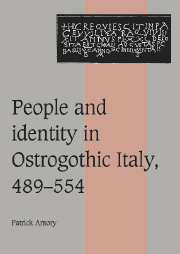Book contents
- Frontmatter
- Contents
- Preface
- List of rulers
- Terminology and vocabulary
- List of abbreviations
- Map of Ostrogothic Italy
- Introduction: Studying the barbarians in late antiquity
- 1 Ethnicity, ethnography and community in the fifth and sixth centuries
- 2 The Ravenna government and ethnographic ideology: from civilitas to bellicositas
- 3 Individual reactions to ideology I: names, language and profession
- 4 Complementary and competing ideals of community: Italy and the Roman Empire
- 5 Individual reactions to ideology II: soldiers, civilians and political allegiance
- 6 Catholic communities and Christian Empire
- 7 Individual reactions to ideology III: Catholics and Arians
- 8 The origin of the Goths and Balkan military culture
- Conclusion
- Appendix 1 The inquiry into Gundila's property: a translation and chronology
- Appendix 2 The Germanic culture construct
- Appendix 3 Archeological and toponymic research on Ostrogothic Italy
- Appendix 4 Dress, hairstyle and military customs
- Prosopographical Appendix: A prosopography of Goths in Italy, 489–554
- Bibliography
- Index
- Cambridge Studies in Medieval Life and Thought Fourth Series
7 - Individual reactions to ideology III: Catholics and Arians
Published online by Cambridge University Press: 03 December 2009
- Frontmatter
- Contents
- Preface
- List of rulers
- Terminology and vocabulary
- List of abbreviations
- Map of Ostrogothic Italy
- Introduction: Studying the barbarians in late antiquity
- 1 Ethnicity, ethnography and community in the fifth and sixth centuries
- 2 The Ravenna government and ethnographic ideology: from civilitas to bellicositas
- 3 Individual reactions to ideology I: names, language and profession
- 4 Complementary and competing ideals of community: Italy and the Roman Empire
- 5 Individual reactions to ideology II: soldiers, civilians and political allegiance
- 6 Catholic communities and Christian Empire
- 7 Individual reactions to ideology III: Catholics and Arians
- 8 The origin of the Goths and Balkan military culture
- Conclusion
- Appendix 1 The inquiry into Gundila's property: a translation and chronology
- Appendix 2 The Germanic culture construct
- Appendix 3 Archeological and toponymic research on Ostrogothic Italy
- Appendix 4 Dress, hairstyle and military customs
- Prosopographical Appendix: A prosopography of Goths in Italy, 489–554
- Bibliography
- Index
- Cambridge Studies in Medieval Life and Thought Fourth Series
Summary
Why did the Arian church under Theoderic call itself the “church of Gothic belief”? Historians have believed that Arianism appealed to the Goths because it helped them to preserve their group identity. No cultural trait has been seen as more fundamental to the definition of an Italian Goth than Arian belief. In the end, according to this interpretation, Ostrogothic Italy could not survive as a kingdom because, unlike Frankish Gaul, the heretical faith of the settlers slowed assimilation and promoted conflict. “[Theoderic's] Arianism was a national identity-card for the Goths.” “We may suspect that for the Goths an essential feature of their Arianism was simply that it was not the faith of the Romans.” “Wherever in Italy there was any substantial Gothic garrison, the Arians had their own church buildings.” “Vero punctum dolens nei rapporti fra Goti e Romani era la diversità di confessione: Teoderico, con la maggioranza del suo seguito, era ariano.”
These statements are questionable. They rest on the following assumptions, each of which would need to be proven: Goths and Romans are easily definable as peoples; one people has only one religion; belonging to a people determines one's religion; and that religion is the same as the religion of the king or the emperor.
These historians understand Arianism as the religion of the Goths because it was the religion of Theoderic, yet members of Theoderic's family were Catholics.
- Type
- Chapter
- Information
- People and Identity in Ostrogothic Italy, 489–554 , pp. 236 - 276Publisher: Cambridge University PressPrint publication year: 1997



